Historical Preservation
DAR Historic Markers
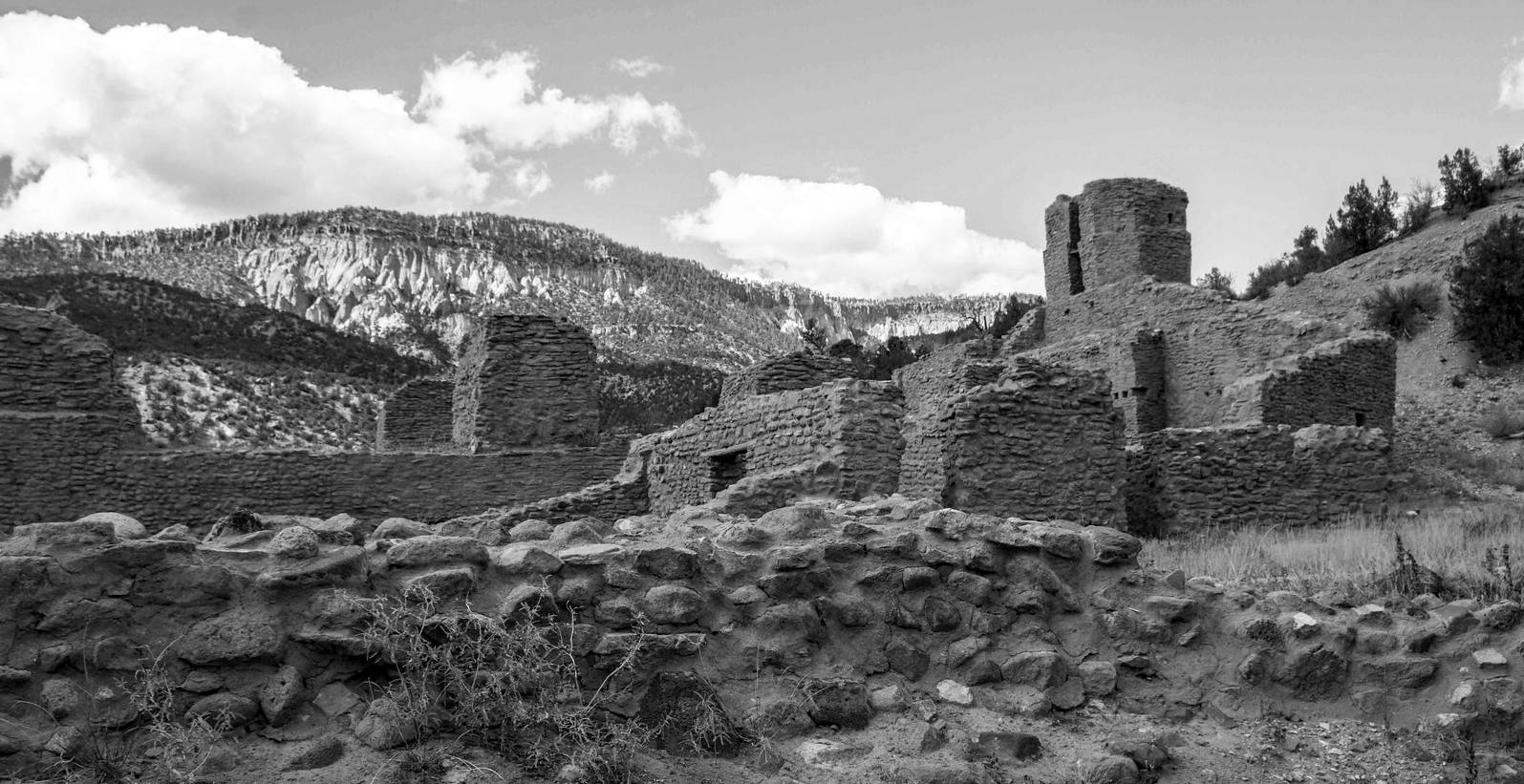









The Tucson Chapter, NSDAR, was organized on February 27, 1915. As the years have passed, DAR members migrated to other areas in Southeast Arizona and formed other chapters. The Southeast Region is presently home to eight DAR chapters: Cienega Creek, organized in 2022; Dry Lake, organized in 2000; El Presidio, organized in 1983; Gila Valley, organized in 2014; Lady Banksia, organized in 2022; Madera Canyon, organized in 1983; Tombstone, organized in 1969; and Tucson, organized in 1915. The DAR historic markers in Tucson represent the early beginnings of our organization’s history in Southeast Arizona.
Eight historic markers were placed in the 1920s and 1930s due to members' concerns regarding the preservation of the historic Presidio (Spanish for fort) San Agustin del Tucson. Two of the original markers were lost but other markers now document these historic locations. All of our markers were donated to the city when they were dedicated.
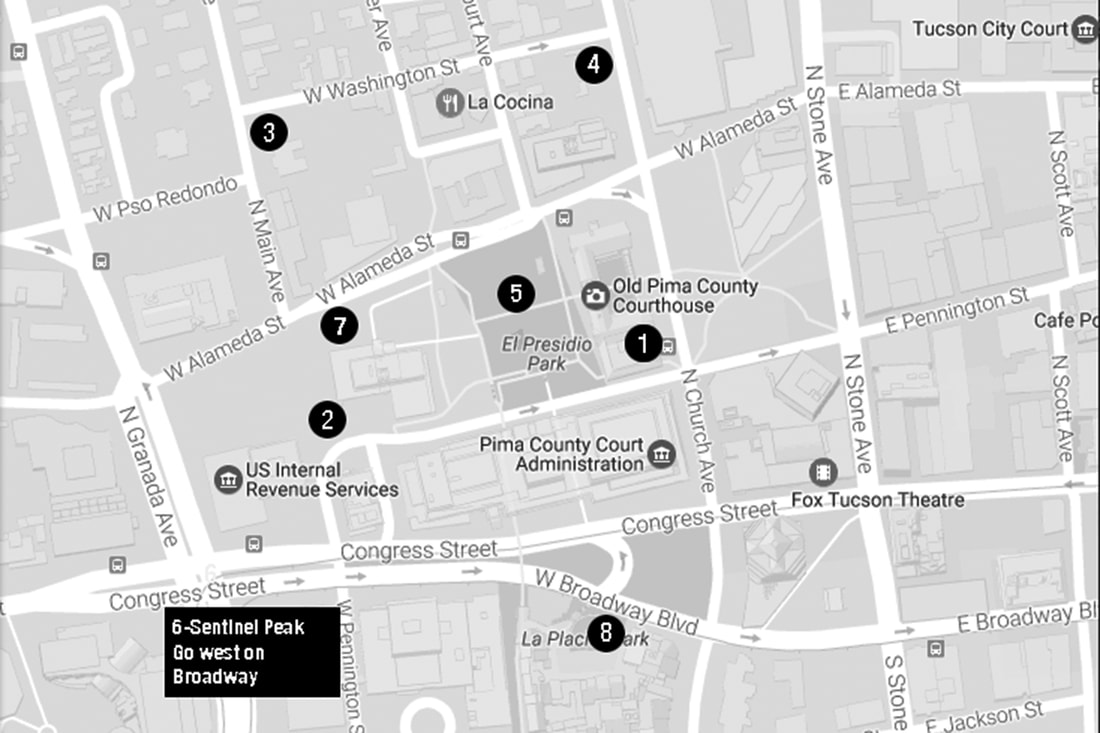

History: The first marker was placed on November 11, 1922, to represent the southeast corner of the Old Adobe Wall of the Presidio. Mrs. Mable Moffett, Chapter Regent of the Tucson Chapter, NSDAR, from 1922-1926, is probably responsible for placing most of the markers. Mrs. Moffitt was a schoolteacher and principal with a special interest in patriotic and historic education. The original marker was an engraved stone granite boulder with the inscription, “This tablet marks the site of the southeast corner of the Old Adobe Wall that protected Tucson from the Indians in the early days prior to 1845.” The stone monument was moved on October 23, 1930, due to construction. The original marker was lost. In 1955 our chapter replaced the marker with a brass one-fourth-circle disc marking the southeast corner. This disc is embedded in the floor of the old Pima County Assessor’s Office.
Dedicated: November 11, 1922
Location: Floor of the old County Assessor’s office
(In the domed Pima County Courthouse)
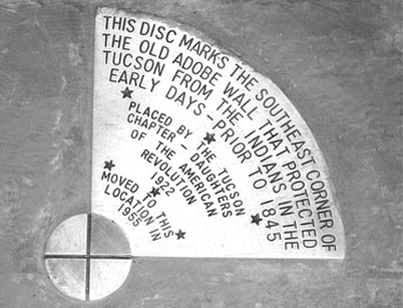
Inscription:
THIS DISC MARKS THE SOUTHEAST CORNER OF THE OLD ADOBE WALL THAT PROTECTED TUCSON FROM THE INDIANS IN THE EARLY DAYS – PRIOR TO 1845
PLACED BY THE TUCSON CHAPTER – DAUGHTERS OF THE AMERICAN REVOLUTION 1922
MOVED TO THIS LOCATION IN 1955

History: The southwest cornerstone marker of the Old Adobe Wall of the Presidio was dedicated at the same time as the northeast and northwest cornerstone markers on March 26, 1926. The dedication by the Tucson Chapter, NSDAR, took place during the DAR state conference that year. All three of these markers were identical bronze plaques less than 10 inches wide.
The bronze southwest cornerstone marker was placed on the Orndorff Hotel but was lost in 1935 when the hotel was demolished to build a parking lot. The hotel was originally built in 1856 and named the Phillips House for its owner. Sam Hughes purchased the hotel from Mr. Phillips renaming it the Cosmopolitan. In 1896 Mr. Hughes sold it to Mrs. A. C. Orndorff. Our chapter’s gavel was made from wood that was recovered from the Orndorff Hotel. The Arizona state regent’s gavel, a gift from our chapter, was also made from this reclaimed wood.
The Tucson Historical Society graciously replaced the southwest corner marker in 1998. The marker is affixed to remnants of the Old Adobe Wall in front of city hall next to the parking lot.
Dedicated: March 26, 1926
Location: Northwest Corner of City Hall Parking Lot (255 West Alameda, parking lot in rear of building)
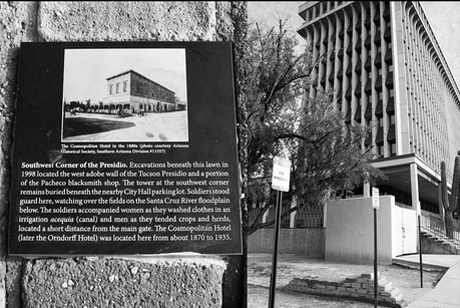
Inscription from the original marker that was lost:
S.W. CORNER
ADOBE WALL OF SPANISH
PRESIDIO OF TUCSON
MARKED 1926 BY D.A.R.

History: The northwest cornerstone marker was dedicated during the DAR state conference held in Tucson on March 26, 1926. The ten-inch bronze plaque is embedded in the block wall surrounding the J. Knox Corbett House at the corner of Washington Street and Main Avenue. The plaque faces Main Avenue.
The Corbet House was built in 1907 and restored in 1995 to a style reflecting the early 1900s. It is situated in the part of town known as “Snob Hill” because of the wealthy families that resided in the area. The house is now part of the Tucson Museum of Art on an historic block in downtown Tucson.
Dedicated: March 26, 1926
Location: Embedded in the wall surrounding the Corbett House at the corner of Washington Street and Main Avenue.
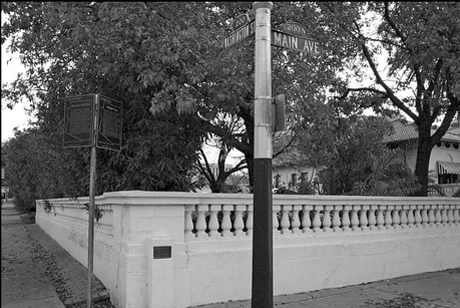
Inscription:
N.W. CORNER
ADOBE WALL OF SPANISH
PRESIDIO OF TUCSON
MARKED 1926 BY D.A.R.

History: Members of the Tucson Chapter, NSDAR, dedicated the marker for the northeast cornerstone of the Presidio’s Old Adobe Wall on March 26, 1926. The marker was placed as close to the original site as possible. Over the years a parking lot was built close to the marker. Pictures were taken in 1976 for the U.S. Bicentennial and the marker was still in place at the original dedication site.
By 1995, when our chapter celebrated its 80th birthday, the marker had disappeared. Mrs. Norma Niblett, a member of the El Presidio Chapter, NSDAR, found the cornerstone marker in 2007 in the basement of the Tucson Historical Society still attached to concrete and metal rods. Thanks to Mrs. Niblett’s keen eye, the northeast corner marker was saved.
In 2006, at a time when the cornerstone was still missing, the parking lot was excavated and a historic park was built recreating the northeast corner of the Presidio San Agustin del Tucson. This park was funded by the City of Tucson’s Rio Nuevo District. The excavation for the park identified the exact corner of the original wall. Chapter members and DAR visitors from around the state rededicated the NE cornerstone marker on March 20, 2008. The marker now identifies the exact location of the northeast corner adobe wall of the Presidio. A picture of the cornerstone marker is published in the paperback book, Presidio San Agustin del Tucson: A View of Early Tucson, can be purchased in the gift shop at the park.
Dedicated: March 26, 1926; Rededicated: March 20, 2008
Location: Northeast corner of Washington Street and Church Avenue inside the recreated northeast corner of the Presidio San Agustin del Tucson Park.
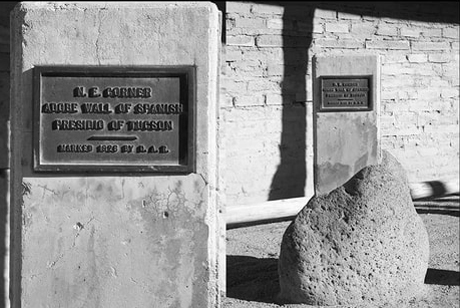
Inscription:
N.E. CORNER
ADOBE WALL OF SPANISH
PRESIDIO OF TUCSON
MARKED 1926 BY D.A.R.

History: The fifth historic marker commemorates the raising of the first American flag within the Walled City of Tucson on December 16, 1846. This occurred during the Mexican-American War when Tucson was part of the Mexican territory.
A group of Army volunteers made up of members of the Mormon Church marched into Tucson to rest for a few days on their journey to California. This group was called the Mormon Battalion. They traded cloth and buttons for needed food, then continued to California. Members of the Mormon Battalion raised the American flag by placing it in a cannon barrel during their stay at the fort.
Dedicated: February 26, 1929
Following repairs this historic marker was rededicated on October 29, 1995.
Location: Northside, by Alameda Street, of the El Presidio Plaza Park in between the present-day city hall and the rear of the old domed Pima County Courthouse.
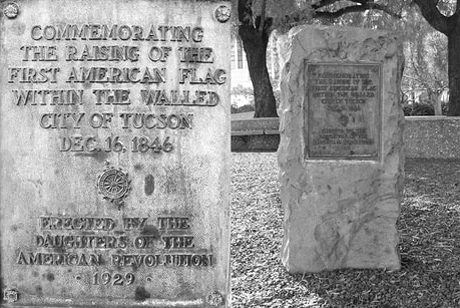
Inscription:
COMMEMORATING THE RAISING OF THE FIRST AMERICAN FLAG WITHIN THE WALLED CITY OF TUCSON
DEC. 16, 1846
ERECTED BY THE
DAUGHTERS OF THE AMERICAN REVOLUTION
1929

History: Sentinel Peak is a 2,897-foot peak in the Tucson Mountains southwest of downtown Tucson. Indians and early settlers used the area as a signal station or lookout to alert others of approaching enemies. In 1775, when the Presidio San Agustin del Tucson was being built, sentinels were stationed on the peak to watch for raiding Apaches. The Sentinel Peak historic marker commemorates the significance of the peak’s signal station.
In 1910 a 160-foot-tall block “A” was constructed by students from the University of Arizona on the east face of the mountain. This led to Sentinel Peak’s other name, “A” Mountain. Today, the peak is part of a park that is the largest natural resource park in Tucson.
Dedicated: March 14, 1933
Location: Below the lower left foot of the big “A” on A Mountain.
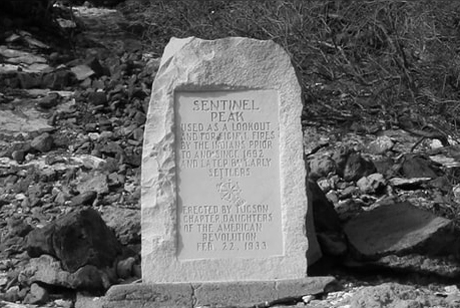
Inscription:
SENTINEL
PEAK
USED AS A LOOKOUT AND FOR SIGNAL FIRES BY THE INDIANS PRIOR TO AND SINCE 1692 AND LATER BY EARLY SETTLERS
ERECTED BY TUCSON CHAPTER DAUGHTERS OF THE AMERICAN REVOLUTION
FEB. 22, 1933

History: This historic marker represents the north entrance to the Old Walled City of Tucson. In a January 16, 1937, newspaper article, a photograph of Mrs. Charles Gulden showed this historic plaque attached to a traditional adobe wall. The article states that the marker was planned for the north entrance to the city after the completion of the new highway.
The marker was dedicated on the same day as the other gateway marker but was never put in its final place due to construction. The marker was eventually placed in the road median on Miracle Mile in 1955 but was stolen in 1982. On April 8, 1984, the marker was mysteriously returned to our chapter regent's home, wrapped in a bed sheet and thrown in her garage.
In 1995, following our chapter's 80th anniversary celebration, the chapter learned that the marker was not stolen, but was taken by a young road construction worker who was told by his supervisor to throw it away. He took the marker home and then learned that the DAR was looking for the “stolen” historic marker. The frightened young man wrapped the marker in a bed sheet and delivered it to the family attorney for its safe return.
The chapter made arrangements to have it mounted in stone and placed as near as possible to the gateway of the Old Walled City. Today, it marks the gateway that opened to the river and mountains to the west.
Dedicated: January 16, 1937
Location: In front of City Hall in El Presidio Park along Alameda Street.
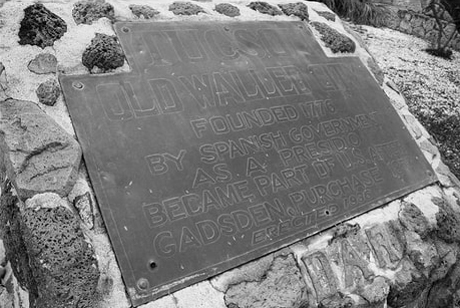
Inscription:
TUCSON
OLD WALLED CITY
FOUNDED 1776
BY SPANISH GOVERNMENT
AS A PRESIDIO
BECAME PART OF U.S. AFTER
GADSDEN PURCHASE 1858
ERECTED 1936
DAR

History: This historic marker represents the south entrance to Tucson’s Old Walled City. This was also the first entrance to the city. It is mounted in brick stonework. Both gateway markers were dedicated on the same day, January 16, 1937.
Mrs. Mabel Moffit, Chapter Regent from 1922-1926, felt that the two gateway markers were much more significant than the four corners of the Presidio. The gateway markers represented people from many diverse backgrounds that came together in the Old Walled City to create the unique Tucson culture.
Dedicated: January 16, 1937
Location: In the iron-gated gazebo area of Plaza de la Mesilla in La Placita Park.
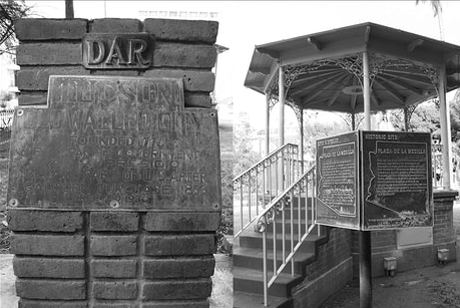
Inscription:
DAR
TUCSON
OLD WALLED CITY
FOUNDED BY THE SPANISH GOVERNMENT
AS A PRESIDIO
BECAME PART OF THE U.S. AFTER
THE GADSDEN PURCHASE OF 1853
ERECTED 1936
For information on historical markers throughout Arizona please visit the Arizona State DAR Historical and Commemorative Markers page.
Contact us to learn more about our Historical Preservation projects and how to become a member of the Tucson Chapter, NSDAR.
The content contained herein does not necessarily represent the position of the NSDAR. Hyperlinks to other sites are not the responsibility of the NSDAR, the state organizations, or individual DAR chapters.
Photos courtesy of Tucson Chapter members and Flickr.






